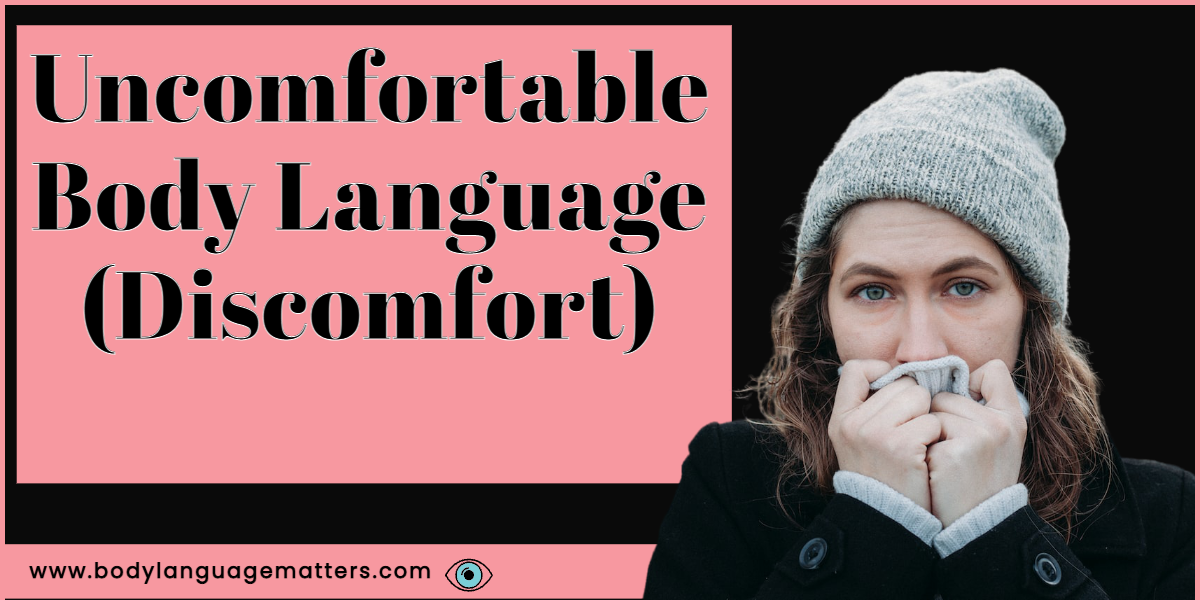So you’ve noticed someone with uncomfortable body language or think you have and want to figure out if this is the case. In this post, we will take a look at 16 common body language cues for discomfort so you can figure it out for yourself.
Uncomfortable body language is when someone’s body language communicates discomfort, unease, or anxiety. This can manifest in many ways, such as fidgeting, averting eye contact, or crossing the arms.
It’s important to be aware of these cues so that you can adjust your behaviour accordingly – for example, by giving the person some space, or asking if they’re okay.
- Why is understanding body language important?
- Body Langauge Clusters.
- 17 Body Language Cues of Someone Who is Uncomfortable.
- Avoiding eye contact.
- Sweating.
- Hands over the face.
- Crossed arms.
- Crossed legs.
- Closed hands.
- Head down.
- Tensing up.
- Fidgeting.
- Checking the time frequently.
- Playing with hair or objects.
- Breathing shift.
- Dry mouth.
- Swallowing hard.
- Move away from you.
- Feet point away from you.
- Notice Facial Expressions
- Final Thoughts.
Why is understanding body language important?
Body language is a form of nonverbal communication in which physical behaviors, as opposed to words, are used to express or convey messages. These behaviors can include facial expressions, body movements, and eye contact.
Understanding body language is important because it can help you to better understand what someone is saying, even if they are not using words. For example, if someone has their arms crossed while they are talking to you, they may be feeling defensive or uncomfortable. Or, if someone is leaning toward you while you are talking, they may be interested in what you have to say. Paying attention to these nonverbal cues can help you to better understand the spoken word.
When it comes to reading body language, the best thing to do is understand the context around what you are seeing. This will give you clues and factual data about what is happening.
If you would like to learn how to read body language, we highly recommend checking out How To Read Body Language Nonverbal Cues (The Correct Way) to help you understand people on a deeper level.
Body Langauge Clusters.
If you don’t want to learn to read body language, you need to understand that we can’t take one body language cue to mean one thing. We need to read clusters of information in a three to five-minute time frame.
A cluster in body language terms is more than one body language cue for example if you see someone avoiding eye contact, or crossing their arms and legs in a conversation you have three data points you can work from in order to figure out if they are feeling uncomfortable.
Next up, we will take a look at the most common body language cues of someone who is uncomfortable.
17 Body Language Cues of Someone Who is Uncomfortable.
- Avoiding eye contact.
- Sweating.
- Hands over the face.
- Crossed arms.
- Crossed legs.
- Closed hands.
- Head down.
- Tensing up.
- Fidgeting.
- Checking the time frequently.
- Playing with hair or objects.
- Breathing shift.
- Dry mouth.
- Swallowing hard.
- Move away from you.
- Feet point away from you.
- Facial expressions.
Avoiding eye contact.
Making eye contact is an important part of communication. It shows that we are interested in the person we are talking to and are engaged in the conversation. Lack of eye contact can be a sign of disinterest or discomfort. It can also make the other person feel disconnected from us. If we are constantly looking away, it may shift the focus of the conversation away from the other person.
Sweating.
One of the most primal human body language behaviours is sweating. Sweating is a way of cooling your body down and getting rid of some toxins. It also means that you’re really hot, uncomfortable, or embarrassed. This is a good sign someone is feeling stressed out or uncomfortable for whatever reason.
Hands over the face.
When we are feeling uncomfortable, we might do some self-soothing gestures without even realizing it. For example, we might twist our hair or raise our hands over our faces. These behaviours can actually make someone else feel uncomfortable, especially if they don’t know us very well.
Crossed arms.
There are many ways our body language may betray how we really feel. When someone crosses their arms, it is a defensive posture that makes them feel more in control. This can also be a cue that the person feels uncomfortable, for example when something is said and they look away from you and cross their arms.
Crossed legs.
Crossed legs give off a closed-off body language, depending on the context. When we read body language, it is usually in clusters of information so you would normally see a few different cues when it comes to crossed legs.
Closed hands.
When people’s hands start to close or begin to close, it can signal that they are becoming uncomfortable. It is a subtle body language cue, but one you should pay attention to.
Head down.
When you notice someone’s head begin to drop in a conversation this could be a sign that they are beginning to feel uncomfortable. For example, if you see someone turn their head away and then drop it to the floor, it could be a way to avoid eye contact.
Tensing up.
Sometimes people will tense up when they experience pressure, discomfort or feeling threatened. You may see this as their hands close into a fist also.
Fidgeting.
When we become uncomfortable we often start to fidget. Fidgeting is a coping mechanism to reduce any nervous energy and try and calm down.
Checking the time frequently.
When we are waiting for something to end and have become uncomfortable, it’s common practice to constantly look at our watch or phone. This allows use to focus on something else in the room and also signals to other you could want to leave.
Playing with hair or objects.
In body language, playing with one’s hair or an object is called an adaptor. This is a way to self-regulate or control one’s feelings, typically seen when someone becomes uncomfortable.
Breathing shift.
If you notice someone breathing faster than normal, it may be because they have shifted within themselves, going from comfortable to uncomfortable. This is something you can often spot in their breathing and in others.
Dry mouth.
When we get nervous or uncomfortable, our mouths go dry, and you will often hear this in a sort of clicking sound. Check out some Ted Talks, and you will often hear this as there is less saliva in the mouth.
Swallowing hard.
Sometimes when someone is uncomfortable in a situation and about to say something they know won’t go over well, a hard swallow or deep gulp can be seen or even heard.
Move away from you.
When someone is talking to you and they distance themselves from you, it is likely that they are subconsciously trying to create a physical and/or emotional barrier between the two of you. This can happen for a variety of reasons but usually indicates that the person is not comfortable with you for some reason. If you notice someone repeatedly doing this, it might be a good idea to try to find out why.
Feet point away from you.
When someone’s feet are pointed away from you, it’s a sign that they’re not interested in talking to you. This is because our body language reflects what’s going on in our minds. If we’re not interested in something, we’ll point our feet away from it. Lack of eye contact is another sign that someone isn’t interested in talking to you. When we’re not interested in something, we avoid making eye contact with it.
Notice Facial Expressions
When we talk to other people, we usually pay attention to their facial expressions and eye contact. This is because our faces can signal how we are feeling, and these signals can be an indicator of what we are thinking. For example, if someone has a sad expression on their face, we might think that they are unhappy. If someone avoids making eye contact, we might think that they are hiding something from us. Paying attention to these cues can help us to better understand the people around us.
Final Thoughts.
There are many ways to tell if someone is uncomfortable through their body language. They may avoid eye contact, have their arms crossed, or be fidgeting. Another way to tell is if they seem tense or stiff. If someone is uncomfortable, they may also be sweating or have a change in their voice (e.g., cracking). You need to read the context of the room, as well as the other person’s body language, to get a sense of what’s going on and then go from there. We hope you have found what you are looking for until next time stay safe.

